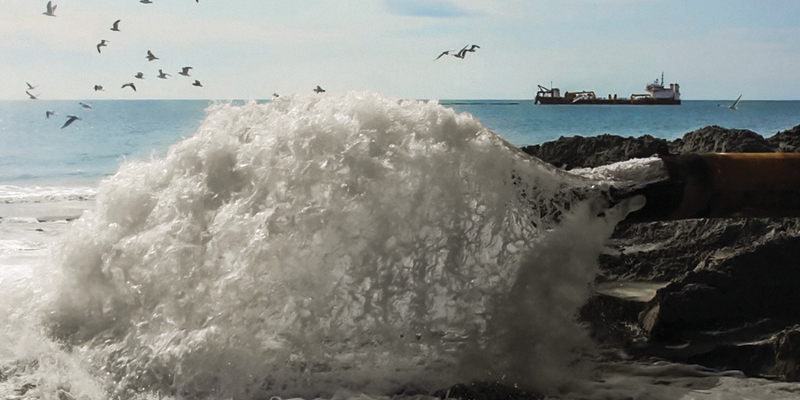Inside a seaside conference center in New Jersey, the best minds in the beach replenishment business meet, steps away from a monument to their profession.
The American Shore and Beach Preservation Association held its national conference last week in Long Branch, N.J., at nearly the center of a 21-mile long beach replenishment project that started in the 1990s.
The Monmouth County project, extending from around the approaches of lower New York Harbor to Manasquan Inlet, was the Corps of Engineers’ demonstration of how pumping sand from the sea floor onto beaches could reduce storm damage along urban shorelines. It is the biggest out of some $1 billion worth of beach projects in New Jersey over the last 30 years.
Days before the Oct. 29 anniversary of Hurricane Sandy in 2012, conference speakers talked about how beach replenishment projects and engineered dunes had protected towns from battering storm waves.
Engineering and dredging companies, like Great Lakes Dredge & Dock Company, are big supporters of the conference. Some $2.7 billion in shoreline protection projects came out of Sandy. With estimates that sea level in the mid-Atlantic states could rise by 1’ to 2.5’ by the 2050s, much more work is sure to come.
In New Jersey’s Long Beach Island, completed sections of the Corps’ beach replenishment project withstood the Sandy storm surge – while incomplete stretches had waves overwash neighborhoods and wreck houses. The Corps came back with another 7 million cubic yards of sand to finish the job.
“Dunes work,” said Lynn Bocamazo, chief of the Corps’ Hurricane Sandy Relief Branch, and a veteran of planning and engineering for the New Jersey beach projects before the storm.
Before engineers really understood the volume and height of sand needed for storm protection — up to 22’ high behind a 100’ wide beach — early attempts at replenishment in the 1980s only lasted a few years, recalled Stewart Farrell, a professor at Richard Stockton College who has monitored the beaches for decades.
Today there is a lot more confidence that engineered beaches and dunes can work. Bocamazo said they proved their worth again in Florida during Hurricane Matthew, when Corps projects protected buildings and public infrastructure from major damage.
Still, skeptics abound. Costs for beach widening projects and their periodic replenishment have been going up, combined with shorter time cycles to make up for storms and erosion, says Rob Young, director for the Center for the Study of Developed Shorelines at West Carolina University.
Coastal scientists are split in a number of ways over the efficacy of beach replenishment. Some like Young see it as a short-term response at best, and public boondoogle at worst.
Others like Farrell see it as a measured response — with the caveat that sea level rise will eventually make its end run around East Coast barrier islands, and creep in with more flooding from the back bays.
No mayors are getting elected in seaside towns by advocating retreat, said Nicole Elko, ASBPA’s vice president for science and technology. Beach replenishment can keep pace with foreseeable conditions in the next decades, she said.
But the back bay sides of the islands will be another front in the struggle — and billions more in dredging and marine construction work.




